Lung Cancer Therapeutics Market Size
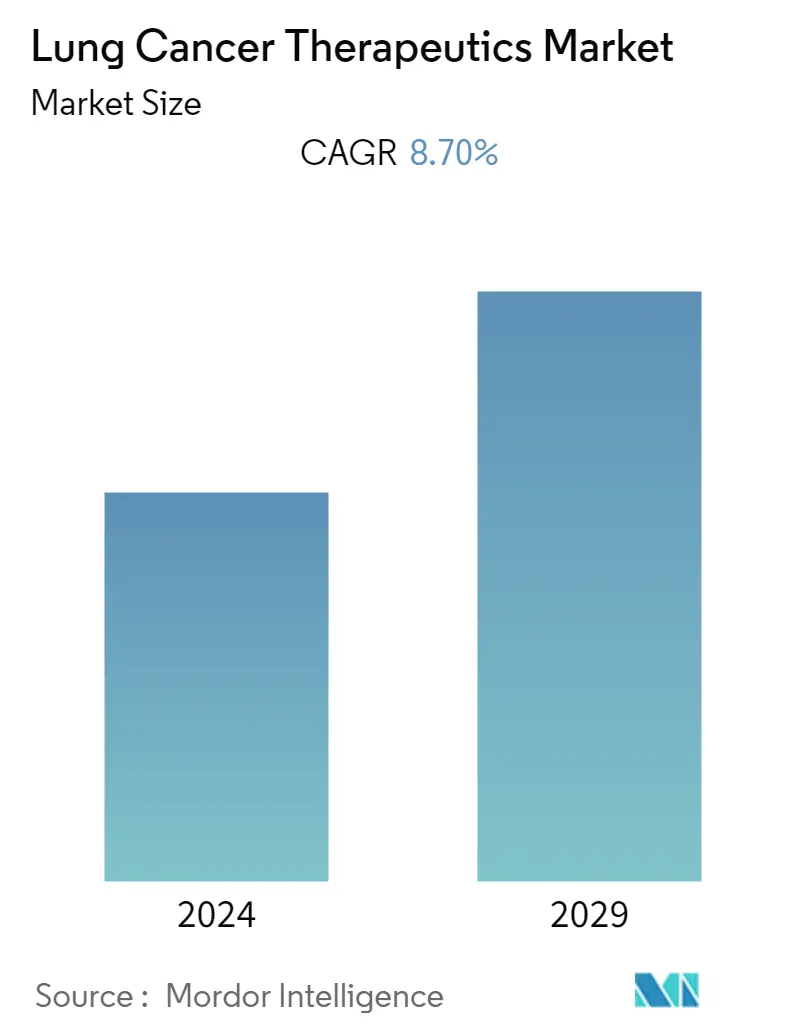
| Study Period | 2019 - 2029 |
| Base Year For Estimation | 2023 |
| CAGR | 8.70 % |
| Fastest Growing Market | Asia Pacific |
| Largest Market | North America |
| Market Concentration | Medium |
Major Players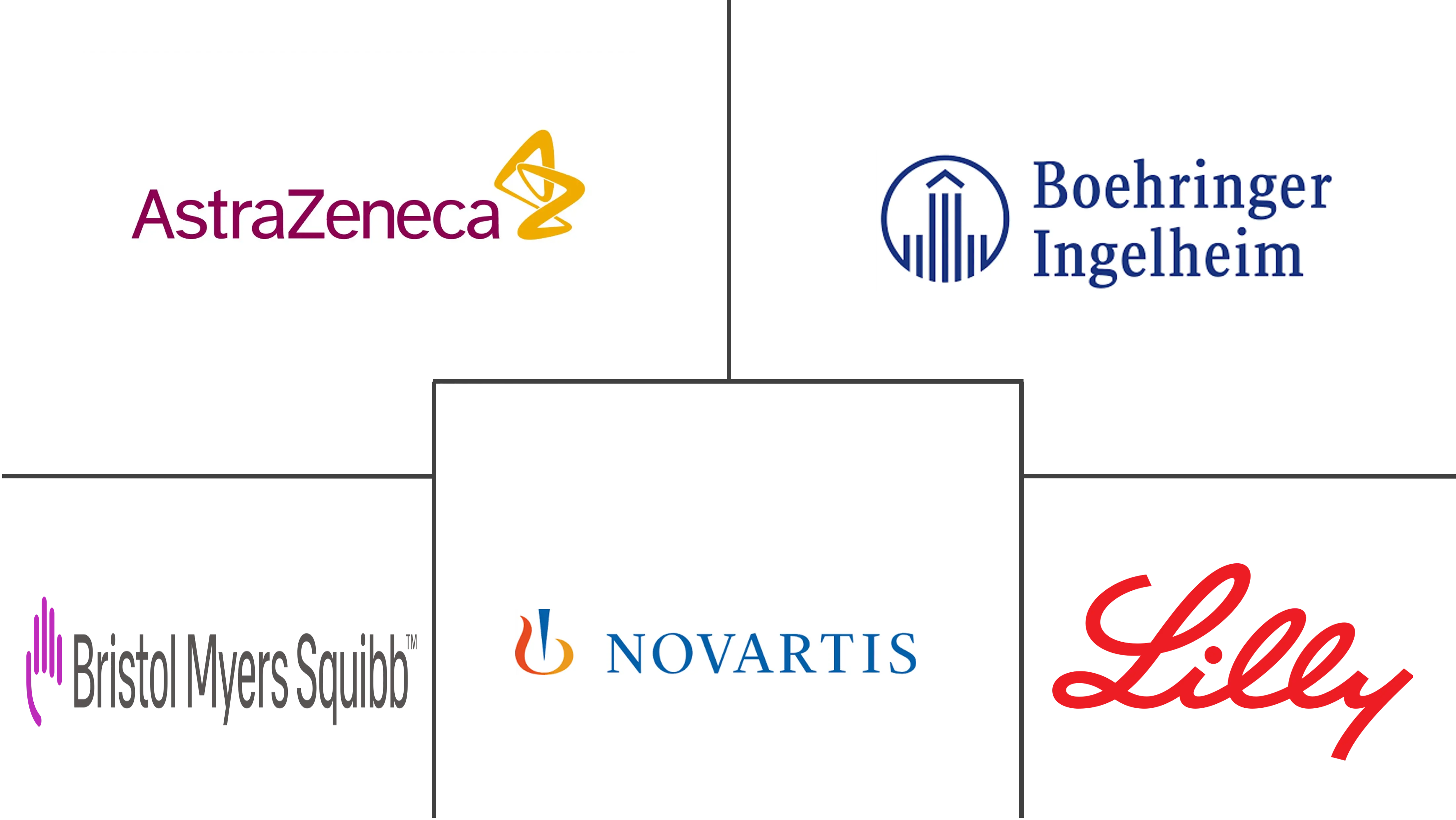
*Disclaimer: Major Players sorted in no particular order |
Lung Cancer Therapeutics Market Analysis
The lung cancer therapeutics market is projected to register a CAGR of 8.7% during the forecast period.
Patients with lung cancer were at a higher risk for SARS-CoV-2 infection as they typically receive immunosuppressive and chemotherapeutic drugs during treatment. Treating patients with lung cancer during the pandemic became a continuous challenge. To overcome the challenge, various organizations partnered to provide solutions and recommendations. For instance, according to an article published by the Journal for Immunotherapy of Cancer in January 2021, the European Society for Radiotherapy and Oncology and the American Society for Radiation Oncology partnered to provide treatment recommendations for stage I-III non-small cell lung cancer (NSCLC), prophylactic cranial irradiation for small cell lung cancer (SCLC), and palliative radiation for NSCLC. Furthermore, according to the above source, recommendations were given for an 'early pandemic scenario,' where the patient and radiotherapy staff risk mitigation was balanced with lung cancer treatment, and the 'later pandemic scenario,' where resources were limited, requiring patient triage. Hence, the initiatives taken by several organizations to overcome the treatment challenge increased the demand for lung cancer therapeutics. Additionally, there is better access to treatment than in the initial pandemic phase due to the lockdown; the market has reached its pre-pandemic level growth and is expected to grow significantly over the forecast period.
Factors driving the market growth include the increasing prevalence of lung cancer, rising pollution due to rapid industrialization, growth in the number of smokers, and increasing funding for the R&D of new drugs. For instance, as per the American Cancer Society's (ACS) data published in 2022, lung cancer (both small and non-small cell) is the second most common cancer in both men and women, making up almost 25% of all cancer deaths. Besides, according to the 2022 report by the American Lung Association, while the disease remains the leading cause of cancer deaths among women and men, the survival rate over the past five years has increased from 21% nationally to 25% yet remains significantly lower among communities of color at 20%. Hence, the increasing prevalence of cancer and the need for effective treatment is likely to contribute to market growth.
Furthermore, acquisitions, partnerships, mergers, and collaborations by the key players are also contributing to the market growth. For instance, in May 2021, Janssen Pharmaceutical reported that the U.S. FDA granted the accelerated approval of RYBREVANTTM (amivantamab-vmjw) for the treatment of adult patients with locally advanced or metastatic non-small cell lung cancer (NSCLC) with epidermal growth factor receptor (EGFR) exon 20 insertion mutations, as detected by an FDA-approved test, whose disease has progressed on or after platinum-based chemotherapy. Such product approvals are also adding to the growth of the market and are likely to do the same over the forecast period.
Hence, as per the factors above, the lung cancer therapeutics market is likely to grow over the forecast period. However, the side effects of drug therapies and the high cost of the treatments have been restraining the market growth.
Lung Cancer Therapeutics Market Trends
Non-small Cell Lung Cancer (NSCLC) is Expected to Hold a Significant Growth in the Market.
Non-small cell lung cancer is a group of lung cancers that behave similarly, such as squamous cell carcinoma and adenocarcinoma. NSCLC is the more common of the two types of lung cancer and hence this is expected to drive segmental growth. For instance, as per the article published by the Cancer Treatment Centers of America in January 2022, lung adenocarcinoma is the most common form of lung cancer, accounting for 30% of all cases overall and about 40% of all non-small cell lung cancer occurrences. As per the same source, squamous cell lung cancer accounts for about 30% of all non-small cell lung cancers and is commonly associated with smoking. In most cases of NSCLC, large-cell undifferentiated carcinoma accounts for 10% to 15% of all cases. Furthermore, according to the American Cancer Society's data updated in 2023, in general, about 80% to 85% of all lung cancers are NSCLC. Hence, this is likely to create demand for cancer therapeutics over the forecast period. Therefore, with a high prevalence of NSCLC compared to small cell lung cancer, the segmental market is expected to grow over the forecast period.
Furthermore, new product developments and launches by the key market players are also boosting segmental growth. For instance, in October 2021, United States FDA approved the immunotherapy drug atezlizumab (Tecentriq) as an additional treatment after surgery and chemotherapy for some patients with non-small cell lung cancer (NSCLC). The recent approval of drugs for the treatment of non-small cell lung cancer is likely to boost the growth of the market during the forecast period.
Hence, due to the above-mentioned factors, the segment is anticipated to witness growth during the forecast period.
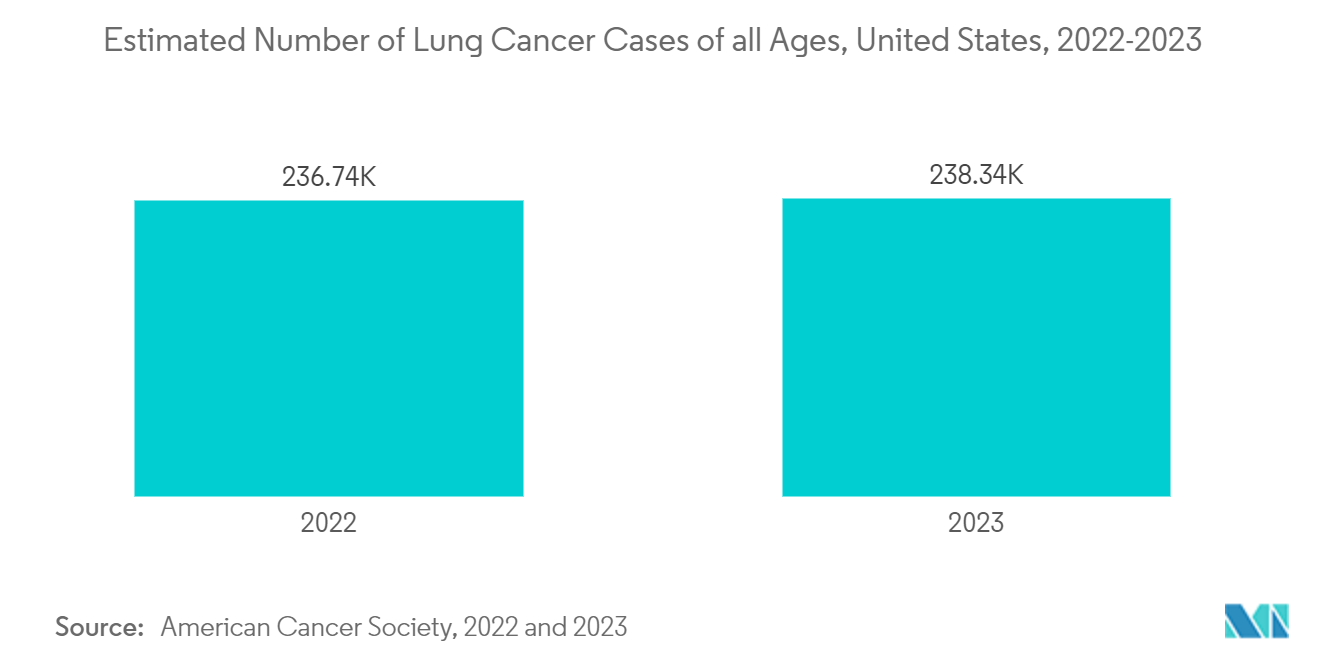
North America is Expected to Hold a Significant Growth in the Lung Cancer Therapeutics Market
North American lung cancer therapeutics market is projected to have a significant market share due to the increasing number of people suffering from lung cancer coupled with the geriatric population. As per the American Cancer Society 2023 report, most people diagnosed with lung cancer are 65 years or older. The average age of people when diagnosed is about 70 years. Additionally, according to the CDC update in March 2022, cigarette smoking accounted for more than 480,000 deaths every year or about 1 in 5 deaths. Smoking damages nearly every organ and is associated with lung cancer. Thus, with an increase in people suffering from lung cancer caused due to smoking and an increase in the geriatric population, the demand for lung cancer therapeutics increases, thereby driving the growth of the market.
Furthermore, product approval in the United States also contributes to market growth. For instance, in May 2021, Amgen announced that the United States FDA had approved LUMAKRAS (sotorasib) for the treatment of adult patients with KRAS G12C-mutated locally advanced or metastatic non-small cell lung cancer, as determined by an FDA-approved test, who have received at least one prior systemic therapy.
As a result, all the aforementioned factors are likely to contribute to this region's strong growth over the forecast period.
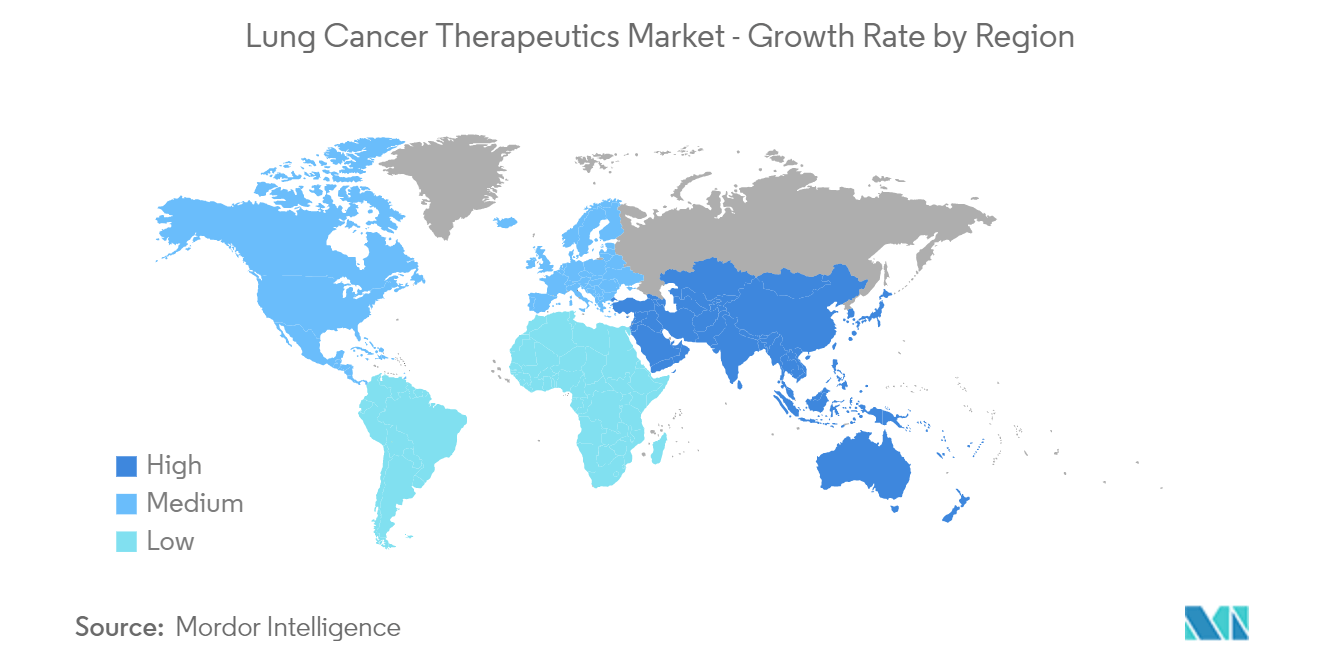
Lung Cancer Therapeutics Industry Overview
The lung cancer therapeutics market is moderately concentrated in nature due to the presence of companies operating globally as well as regionally. The competitive landscape includes an analysis of a few international as well as local companies which hold market shares and are well known including AstraZeneca, Boehringer Ingelheim, Bristol-Myers Squibb Company, Eli Lilly and Company, Merck & Co., Pfizer Inc., Amgen Inc., and Novartis AG, among others.
Lung Cancer Therapeutics Market Leaders
-
AstraZeneca
-
Boehringer Ingelheim
-
Bristol-Myers Squibb Company
-
Novartis AG
-
Eli Lilly and Company
*Disclaimer: Major Players sorted in no particular order
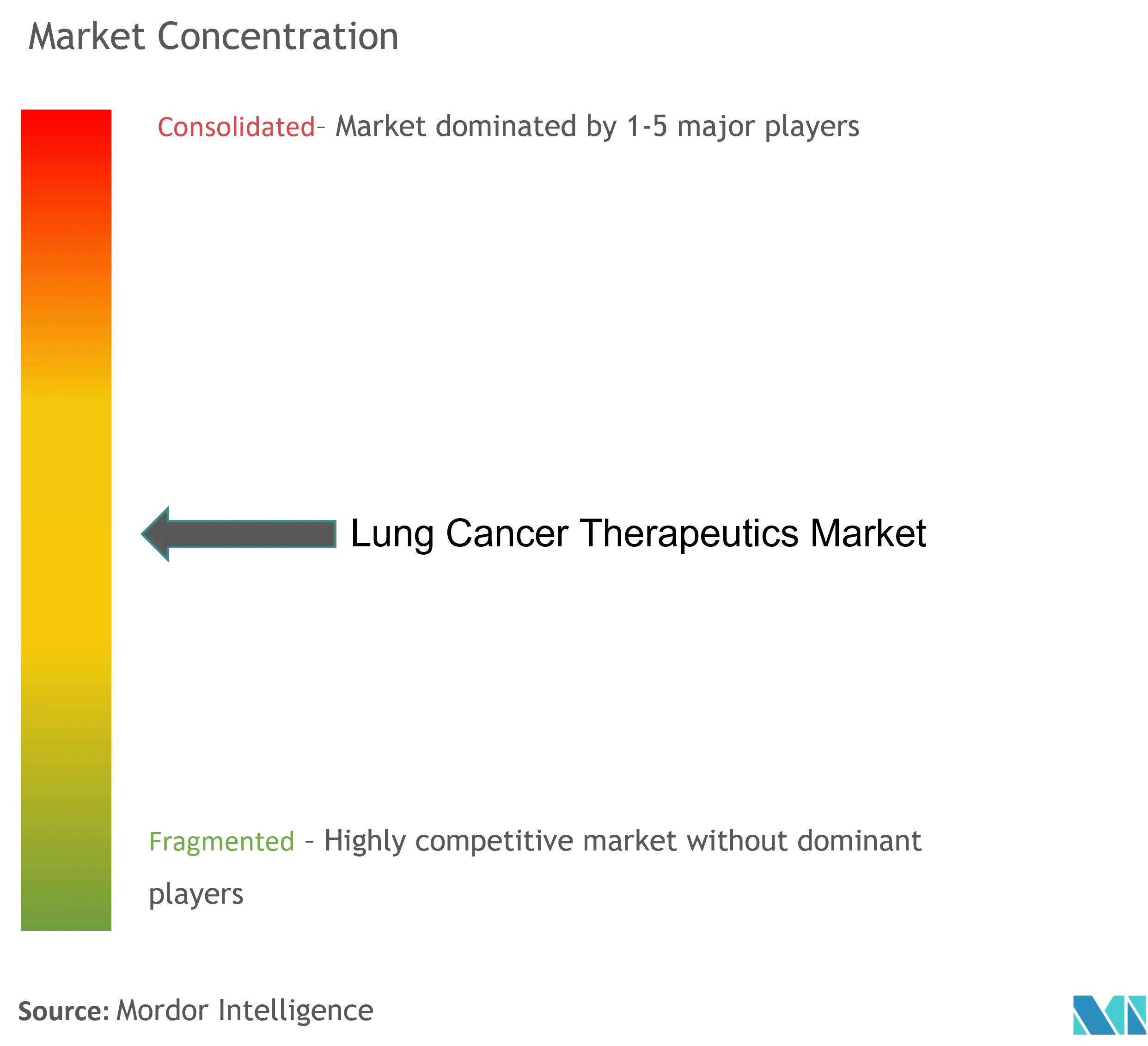
Lung Cancer Therapeutics Market News
- In June 2022, Novartis received approval from European Commission for Tabrecta for the treatment of METex14 skipping advanced non-small cell lung cancer.
- In April 2022, AstraZeneca and Daiichi Sankyo received the acceptance of the supplemental Biologics License Application for Enhertu (trastuzumab deruxtecan) for the treatment of adult patients in the United States with unresectable or metastatic non-small cell lung cancer (NSCLC), by the United States FDA.
Lung Cancer Therapeutics Market Report - Table of Contents
1. INTRODUCTION
- 1.1 Study Assumptions and Market Definition
- 1.2 Scope of the Study
2. RESEARCH METHODOLOGY
3. EXECUTIVE SUMMARY
4. MARKET DYNAMICS
- 4.1 Market Overview
-
4.2 Market Drivers
- 4.2.1 Increasing Prevalence of Lung Cancer
- 4.2.2 Rising Pollution due to Rapid Industrialization and Rise in the Number of Smokers
- 4.2.3 Increasing Funding in the Field of Research and Development of New Drugs
-
4.3 Market Restraints
- 4.3.1 Side Effects of Drugs
- 4.3.2 High Cost of Therapies
-
4.4 Porter's Five Force Analysis
- 4.4.1 Threat of New Entrants
- 4.4.2 Bargaining Power of Buyers/Consumers
- 4.4.3 Bargaining Power of Suppliers
- 4.4.4 Threat of Substitute Products
- 4.4.5 Intensity of Competitive Rivalry
5. MARKET SEGMENTATION (Market Size by Value - USD million)
-
5.1 By Disease Type
- 5.1.1 Non-small Cell Lung Cancer (NSCLC)
- 5.1.2 Small Cell Lung Cancer (SCLC)
-
5.2 By Treatment
- 5.2.1 Chemotherapy
- 5.2.2 Radiation Therapy
- 5.2.3 Immunotherapy
- 5.2.4 Targeted Therapy
- 5.2.5 Other Treatments
-
5.3 Geography
- 5.3.1 North America
- 5.3.1.1 United States
- 5.3.1.2 Canada
- 5.3.1.3 Mexico
- 5.3.2 Europe
- 5.3.2.1 Germany
- 5.3.2.2 United Kingdom
- 5.3.2.3 France
- 5.3.2.4 Italy
- 5.3.2.5 Spain
- 5.3.2.6 Rest of Europe
- 5.3.3 Asia-Pacific
- 5.3.3.1 China
- 5.3.3.2 Japan
- 5.3.3.3 India
- 5.3.3.4 Australia
- 5.3.3.5 South Korea
- 5.3.3.6 Rest of Asia-Pacific
- 5.3.4 Middle East and Africa
- 5.3.4.1 GCC
- 5.3.4.2 South Africa
- 5.3.4.3 Rest of Middle East and Africa
- 5.3.5 South America
- 5.3.5.1 Brazil
- 5.3.5.2 Argentina
- 5.3.5.3 Rest of South America
6. COMPETITIVE LANDSCAPE
-
6.1 Company Profiles
- 6.1.1 AstraZeneca
- 6.1.2 Boehringer Ingelheim
- 6.1.3 Bristol-Myers Squibb Company
- 6.1.4 Eli Lilly and Company
- 6.1.5 Hoffmann-La Roche
- 6.1.6 Merck & Co.
- 6.1.7 Pfizer Inc.
- 6.1.8 Teva Pharmaceutical Industries Ltd.
- 6.1.9 Abbvie (Allergan)
- 6.1.10 Johnson & Johnson (Janssen Pharmaceuticals)
- 6.1.11 Amgen Inc.
- 6.1.12 Novartis AG
- *List Not Exhaustive
7. MARKET OPPORTUNITIES AND FUTURE TRENDS
** Subject To AvailablityLung Cancer Therapeutics Industry Segmentation
As per the scope of the report, lung cancer or lung carcinoma is a disease characterized by uncontrolled cell growth in the lungs. Common symptoms include cough, chest pain, weight loss, and shortness of breath. Lung cancer therapeutic drugs and surgery are therapies aimed at diminishing, stunting, destroying, or killing the cancerous growth and cells in the lungs. The Lung Cancer Therapeutics Market is Segmented by Disease Type (Non-small Cell Lung Cancer and Small Cell Lung Cancer), Treatment (Chemotherapy, Radiation Therapy, Immunotherapy, Targeted Therapy, and Other Treatments), and Geography (North America, Europe, Asia-Pacific, Middle East and Africa, and South America). The Market report also covers the estimated market sizes and trends of 17 countries across major regions globally. The report offers the value (in USD million) for all the above segments.
| By Disease Type | Non-small Cell Lung Cancer (NSCLC) | |
| Small Cell Lung Cancer (SCLC) | ||
| By Treatment | Chemotherapy | |
| Radiation Therapy | ||
| Immunotherapy | ||
| Targeted Therapy | ||
| Other Treatments | ||
| Geography | North America | United States |
| Canada | ||
| Mexico | ||
| Geography | Europe | Germany |
| United Kingdom | ||
| France | ||
| Italy | ||
| Spain | ||
| Rest of Europe | ||
| Geography | Asia-Pacific | China |
| Japan | ||
| India | ||
| Australia | ||
| South Korea | ||
| Rest of Asia-Pacific | ||
| Geography | Middle East and Africa | GCC |
| South Africa | ||
| Rest of Middle East and Africa | ||
| Geography | South America | Brazil |
| Argentina | ||
| Rest of South America |
Lung Cancer Therapeutics Market Research FAQs
What is the current Global Lung Cancer Therapeutics Market size?
The Global Lung Cancer Therapeutics Market is projected to register a CAGR of 8.70% during the forecast period (2024-2029)
Who are the key players in Global Lung Cancer Therapeutics Market?
AstraZeneca, Boehringer Ingelheim, Bristol-Myers Squibb Company, Novartis AG and Eli Lilly and Company are the major companies operating in the Global Lung Cancer Therapeutics Market.
Which is the fastest growing region in Global Lung Cancer Therapeutics Market?
Asia Pacific is estimated to grow at the highest CAGR over the forecast period (2024-2029).
Which region has the biggest share in Global Lung Cancer Therapeutics Market?
In 2024, the North America accounts for the largest market share in Global Lung Cancer Therapeutics Market.
What years does this Global Lung Cancer Therapeutics Market cover?
The report covers the Global Lung Cancer Therapeutics Market historical market size for years: 2019, 2020, 2021, 2022 and 2023. The report also forecasts the Global Lung Cancer Therapeutics Market size for years: 2024, 2025, 2026, 2027, 2028 and 2029.
Lung Cancer Therapeutics Industry Report
Statistics for the 2024 Lung Cancer Therapeutics market share, size and revenue growth rate, created by Mordor Intelligence™ Industry Reports. Lung Cancer Therapeutics analysis includes a market forecast outlook to 2029 and historical overview. Get a sample of this industry analysis as a free report PDF download.



